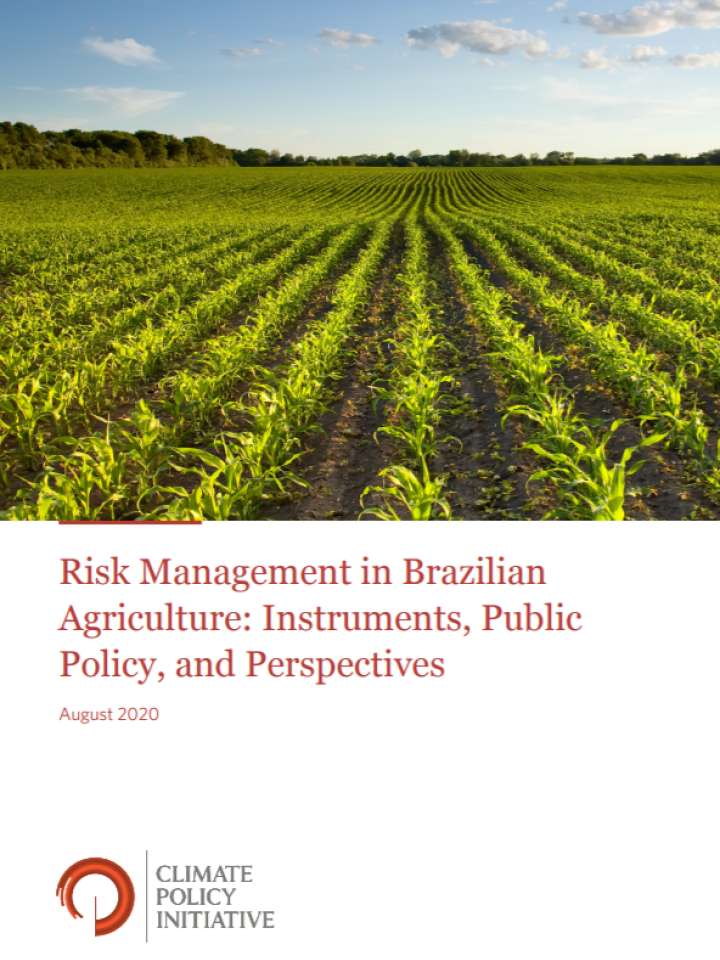Risk management in Brazilian agriculture: instruments, public policy, and perspectives
Rural producers face a wide range of adverse events that expose them to potentially heavy losses. In agriculture, both natural risks – such as droughts, floods, pests, diseases, and fires – and market risks – such as price variation – are frequent. While the modernization of the agricultural sector leads to commodity specialization and the adoption of technologies with higher expected returns, it may also result in a larger production variance, creating more uncertainty and increasing producers’ exposure to risk (See Dercon and Christiaensen, 2011). Modernization has accelerated in Brazil in recent years, raising the importance of risk management instruments.
Brazil has a large potential for improving risk mitigation opportunities for its producers, which will be even more essential in the face of climate change. Improving risk management practices and public policies could accelerate the process of modernization and sustainability in Brazilian agricultural production. Government incentives require a design crafted to meet producers’ needs. In this report, Climate Policy Initiative/Pontifical Catholic University of Rio de Janeiro (CPI/PUC-Rio) researchers analyze the current risk management instruments and public policies and discuss pathways for improving their impact on Brazilian agriculture.
This report discusses the strengths and shortcomings of the main public policies regarding agricultural risk management, highlights the potential for rural insurance growth, and outlines steps for the future. It brings together data from SUSEP, the Ministry of Agriculture (Ministério da Agricultura, Pecuária e Abastecimento – MAPA), the Central Bank of Brazil, and other relevant sources. The empirical analysis aims to provide a better understanding of the current state and recent trends of agricultural risk management in Brazil and to identify how to better tailor public policies.
In Brazil, the modernization of agriculture in the past decades has led to the conversion of pasture to cropland, reducing deforestation pressure associated with the expansion of agricultural land. The continuation of this process requires additional investments in intensification and productivity, particularly in pastureland, so that increases in livestock production do not require area expansion. Simultaneously, the conversion of pastures to cropland significantly alters a business’ risk profile, since crops are more susceptible to climate variations. Livestock farming is generally more resilient in the face of the unforeseen events that often impact rural activities. Specialization of cultures, adoption of new technologies, and sustainable production methods lead to higher expected returns but may cause greater uncertainty in results. Thus, to encourage producers to adopt such practices, their exposure to risk needs to be addressed. That is why the modernization of the agricultural sector enhances the importance of better opportunities for producers to manage their risks.
Market failures in rural insurance have broad consequences leading to underinvestment, less efficient agricultural production, and adverse land use impacts. Producers with inadequate risk management tools often make poor production decisions, such as avoiding crop specialization or the adoption of new technologies that can subsequently increase their exposure to risk. That is, producers will often avoid engaging in activities that have higher expected profits but more uncertainty in returns as a way to self-insure against both natural and price risks. This behavior has negative effects on agricultural productivity and land use, with important consequences for forests and the environment.
In Brazil, rural insurance and other tools for agriculture risk management is scarce and difficult to access in many regions (see Box 1 for an overview of Brazil’s risk management instruments). In 2018, almost 60% of the country’s municipalities had no rural insurance contracts (for crop, livestock, or forest), according to the Superintendence for Private Insurance (Superintendência de Seguros Privados – SUSEP). Moreover, few crops in Brazil are insured, and soy is most frequently covered (32% of crop insurance contracts in SUSEP). Nevertheless, the Brazilian rural insurance market recently experienced significant growth. The rural insurance premium increased from R$88.2 million in 2006 to R$2 billion in 2018, corresponding (adjusted for inflation) to a twelve-fold increase (SUSEP). Life insurance for rural producers makes up 20% percent of all rural insurance premiums, though this type of insurance does not have a direct impact on production choices.
Only a few companies dominate Brazil’ rural insurance market. In the 2019/20 agricultural year, one company represented 52.3% percent of the market and only 14 insurers total were present during that year, according to data from SUSEP. Public policy should provide incentives to reduce market concentration, increase competition among firms, and, consequently, increase the variety of risk management instruments available to rural producers.
The remainder of this report proceeds as follows. Following this Executive Summary, Box 1 gives a brief description of Brazil’s risk management instruments. The main recommendations for improving Brazil,s agricultural risk management policies are highlighted next. Section 1 starts the analysis of risk management instruments in Brazil, exploring the data from SUSEP. Section 2 discusses the four main public policies for Brazilian producers: PSR, PROAGRO, Garantia-Safra, and PGPM. Section 3 describes the Agricultural Climate Risk Zoning (Zoneamento Agrícola de Risco Climático – ZARC). Section 4 presents the Brazilian reinsurance market and the Rural Insurance Stability Fund (FESR). Section 5 reviews the economic literature on how risk management instruments impact agricultural activity and land use in Brazil and other developing countries. Section 6 makes an international comparison of insurance coverage and policies. Finally, Section 7 discusses the pathways ahead and suggestions to improve Brazil’s risk management instruments and public policies.
Explore further
